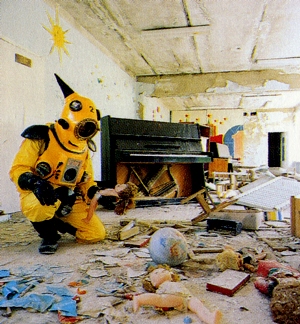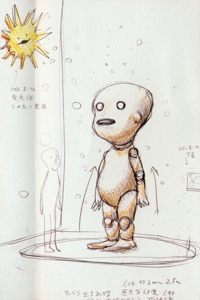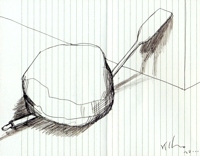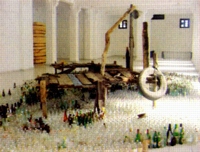| The work of Kcho and Yanobe are in most ways light years apart. One uses
rubbish and discarded washed up materials while the other incorporates Geiger
counters, motors and high-tech materials in his art. Kcho deals in issues
of isolation, while Yanobe tinkers in an artistic pseudo-science with an
interest in radiation. Yanobe's works have a comic book style while Kcho
uses the flotsam and jetsam of life in an assemblage. However, together
they form an interesting comment on the human condition. These are installations
of passion and commitment. A huge Ð nearly 3-meter tall metal 'baby doll'
confronts you as you enter the sleek art space of the Shiseido gallery.
This armored infant is collapsed head down crouching. With the whirr of
engines and the pumping of pneumatic tubes it slowly stirs like a monster
from some deep sleep. It raises itself until it stands straight and tall.
You wait watching to witness it taking its first steps. It hovers; then
slumps back to where it started. This metamorphosis into action is triggered
by ambient radiation. When sufficient radiation falls on the Geiger counter
hidden in the doll's magic works box, it will awaken once more and struggle
for a few seconds of life. Watching over these proceedings is a bright yellow
sun. A cartoon like sun with a smiley face and eyes. It glows as it is lit.
From its mouth spew bubbles Ð soap bubbles Ð the innocent games of children.
However, in connection with Yanobe's other creation they become a metaphor
for radiation. Also included in the exhibition is a photograph from Yanobe's
visit to Chernobyl Ð site of the world's worst nuclear disaster. On close
inspection of the photograph, a deserted schoolroom, one sees on the back
wall the yellow sun with a smiling face. In Yanobe's gloved hands he holds
a baby doll and in the foreground is another spread-eagled, discarded on
the floor. In Chernobyl Yanobe donned his distinctive Yellow suit and helmet
reminiscent of a 19th century diving suit and helmet- but adorned with Geiger
counters and gadgets. It's a cartoon like creation. It is an uneasy sight
of something so comic amongst such serious devastation. "I am the last son
of the bubble period in Japan" declared Yanobe, who draws inspiration from
Manga and science fiction. The sea is powerful force for artist Kcho (KA-cho).
Boats are a recurring element in his work. Born Alexis Leya Machado in Nueva
Greona Isla de la Juventud, Cuba in 1970, he lives and works in Havana.
When you live on an island boats, have a special significance. When that
island is Cuba, boats take on even more significance. Balseros Ð boat people
Ð were the Cubasns who so desperately sought a new life in the States by
travelling the seas between politics in rickety wooden vessels. These images
witnessed by the world on television news become the backdrop for Kcho's
art. He uses water-worn ropes and sea logged wood to construct islands and
jetties. He brings discarded boats and oars into the gallery and places
them as if they had just crashed against the shore Ð broken wrecks. In Kcho's
installation a vast spread of bottles covers the gallery floor. It is not
without irony that he uses hundreds of discarded medical bottles, many of
which once dripped saline solution into Cuban patient's arms, as a metaphor
for the sea. Both Kcho and Yanobe were artists included in the recent Museum
of Contemporary Art Tokyo's recent exhibition "Gift of Hope". Perhaps the
strongest common thread between them is their use of irony in commenting
upon our world. |




|


